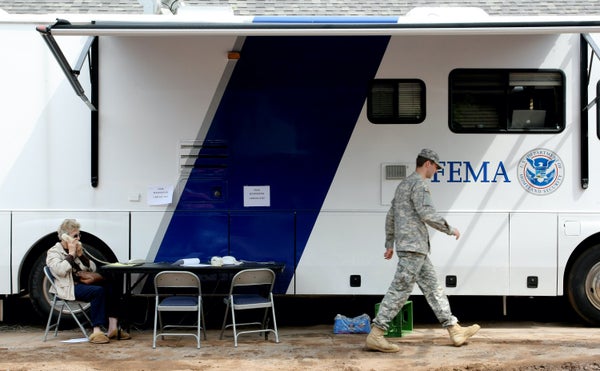Thirty-one years ago, the federal government began rewarding communities that took action to minimize their flood risk with an innovative program that gives residents discounts on their flood insurance premiums.
The Community Rating System is popular—roughly 3.5 million property owners are getting discounts on flood policies they buy through the federal National Flood Insurance Program because their government has done something noteworthy to reduce flood damage.
But a Brown University researcher says the program is doing little to improve the nation’s flood resilience because it doesn’t actually encourage communities to take new steps.
On supporting science journalism
If you're enjoying this article, consider supporting our award-winning journalism by subscribing. By purchasing a subscription you are helping to ensure the future of impactful stories about the discoveries and ideas shaping our world today.
Rather, the Community Rating System, known as the CRS, merely rewards communities for actions they have already taken.
And communities that join the program are those that have the capacity to undertake the extensive paperwork that is required to submit an application. Those are generally large communities with adequate planning staff—or small, wealthy communities with the money to hire a consultant.
“You either need to be big or you need to be rich,” Brown graduate student Jon Nelson said at a recent flood conference. “It’s bureaucratic capacity.”
Nelson’s research, which he summarized at a Columbia University conference last month on managed retreat, adds to the growing number of questions about the CRS and its effectiveness and fairness.
A Government Accountability Office report last year found that numerous communities struggle to hire or retain staff needed for flood-related activities such as “fulfilling CRS paperwork requirements.”
An analysis in 2016 by the University of Pennsylvania’s Wharton Risk Management and Decision Processes Center found that most communities “undertake only those activities that are fairly easy to undertake.”
And a 2017 study published in the International Journal of Disaster Risk Reduction found that “the main reason for not joining the CRS is lack of resources.”
In a synopsis of his research provided at the Columbia conference, Nelson wrote that local planners “are happy to participate in the CRS if they have adequate capacity to undertake the onerous documentation required.” But participation in the CRS “has little bearing on their efforts to adapt to sea-level rise.”
“This suggests that the program is not only largely ineffective, but that it is effectively a subsidy to better-off communities with the ability to join,” he said.
Nelson interviewed municipal officials in Rhode Island for his research and found that the CRS incentives—insurance discounts—did not encourage town planners to join the program. Residents didn’t lobby local officials to join the CRS because they didn’t know about the discounts.
“The biggest determinant of CRS participation is your planning capacity,” Nelson said in an interview. “If you only have one planner, you’re not going to be in the CRS.”
Nelson also found that communities participating in the CRS were no more likely than non-CRS communities to take flood-mitigation steps such as acquiring open space to absorb floodwaters and protect a community.
“Maybe they did great things prior to applying. But I don’t see any evidence that it’s changing their behavior,” Nelson said of communities that participate in the CRS. “There are communities that are not in the CRS that are doing great things.”
Nelson’s research for a doctoral dissertation comes at a pivotal time.
The Federal Emergency Management Agency, which runs the CRS and the federal flood-insurance program, is undertaking a sweeping review of its programs to determine if they can be made more equitable for underserved communities.
At the same time, FEMA is planning to restructure its insurance rates and charge millions of policyholders higher premiums—a move that may spur more communities to join the CRS and get insurance discounts for their residents.
FEMA said in response to questions about Nelson’s research that the agency “is grateful to the academic community for their many contributions to our understanding of the efficacy” of the CRS. FEMA said it is “interested in learning more about Jon Nelson’s findings.”
The CRS enables communities to win insurance discounts for their residents of up to 45% by taking various actions to improve flood resilience. Communities are rewarded for steps such as effectively informing residents of flood risk, requiring buildings in flood zones to be elevated and clearing floodplains of development.
Although 70% of the 5 million people who buy flood insurance through FEMA’s NFIP get some level of discount through the CRS, those people are concentrated in major metro areas such as Los Angeles, Miami, New Orleans and Houston.
But only 1,500 of the 20,000 communities that offer federal flood insurance participate in the CRS program, reflecting the difficulty of joining.
Nelson said that during his interviews with local planners in New England, a few said they made a conscious decision not to join the CRS because they felt the insurance discounts “distort the price signal of flood risk.”
Other planners thought the program gave them “leverage against developers” because they could turn down projects with the argument that building in a floodplain would forfeit the community’s insurance discount, Nelson said.
“There are a ton of good ideas in the CRS manual for reducing your flood risk,” Nelson said. He suggests FEMA provide communities technical assistance—instead of insurance discounts—to help them implement flood mitigation.
“I think it’s a well-intentioned program, but communities have figured out how to game it,” Nelson said.
Reprinted from E&E News with permission from POLITICO, LLC. Copyright 2021. E&E News provides essential news for energy and environment professionals.
